Scoliosis: density-equalizing mapping and scientometric analysis
- PMID: 19638232
- PMCID: PMC2732600
- DOI: 10.1186/1748-7161-4-15
Scoliosis: density-equalizing mapping and scientometric analysis
Abstract
Background: Publications related to scoliosis have increased enormously. A differentiation between publications of major and minor importance has become difficult even for experts. Scientometric data on developments and tendencies in scoliosis research has not been available to date. The aim of the current study was to evaluate the scientific efforts of scoliosis research both quantitatively and qualitatively.
Methods: Large-scale data analysis, density-equalizing algorithms and scientometric methods were used to evaluate both the quantity and quality of research achievements of scientists studying scoliosis. Density-equalizing algorithms were applied to data retrieved from ISI-Web.
Results: From 1904 to 2007, 8,186 items pertaining to scoliosis were published and included in the database. The studies were published in 76 countries: the USA, the U.K. and Canada being the most productive centers. The Washington University (St. Louis, Missouri) was identified as the most prolific institution during that period, and orthopedics represented by far the most productive medical discipline. "BRADFORD, DS" is the most productive author (146 items), and "DANSEREAU, J" is the author with the highest scientific impact (h-index of 27).
Conclusion: Our results suggest that currently established measures of research output (i.e. impact factor, h-index) should be evaluated critically because phenomena, such as self-citation and co-authorship, distort the results and limit the value of the conclusions that may be drawn from these measures. Qualitative statements are just tractable by the comparison of the parameters with respect to multiple linkages. In order to obtain more objective evaluation tools, new measurements need to be developed.
Figures

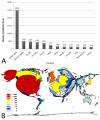

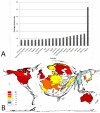

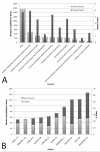
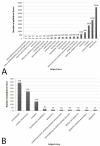
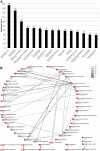
Similar articles
-
Rotavirus - Global research density equalizing mapping and gender analysis.Vaccine. 2016 Jan 2;34(1):90-100. doi: 10.1016/j.vaccine.2015.11.002. Epub 2015 Nov 21. Vaccine. 2016. PMID: 26611203
-
Influenza: a scientometric and density-equalizing analysis.BMC Infect Dis. 2013 Sep 30;13:454. doi: 10.1186/1471-2334-13-454. BMC Infect Dis. 2013. PMID: 24079616 Free PMC article.
-
Gout: a critical analysis of scientific development.Rheumatol Int. 2013 Nov;33(11):2743-50. doi: 10.1007/s00296-013-2805-1. Epub 2013 Jun 25. Rheumatol Int. 2013. PMID: 23797780
-
Global architecture of gestational diabetes research: density-equalizing mapping studies and gender analysis.Nutr J. 2016 Apr 4;15:36. doi: 10.1186/s12937-016-0154-0. Nutr J. 2016. PMID: 27044432 Free PMC article. Review.
-
Biliary atresia: a scientometric analysis of the global research architecture and scientific developments.J Hepatobiliary Pancreat Sci. 2019 Jun;26(6):201-210. doi: 10.1002/jhbp.628. Epub 2019 May 21. J Hepatobiliary Pancreat Sci. 2019. PMID: 30980482 Review.
Cited by
-
A bibliometric analysis of bipolar affective disorders using density-equalizing mapping and output benchmarking.Indian J Psychiatry. 2012 Oct;54(4):320-6. doi: 10.4103/0019-5545.104807. Indian J Psychiatry. 2012. PMID: 23372233 Free PMC article.
-
Citation Analysis and Mapping of Iranian's Stem Cell Research Output.Med J Islam Repub Iran. 2023 Apr 5;37:33. doi: 10.47176/mjiri.37.33. eCollection 2023. Med J Islam Repub Iran. 2023. PMID: 37521127 Free PMC article.
-
New quality and quantity indices in science (NewQIS): results of the first decade-project progress review.Scientometrics. 2019;121(1):451-478. doi: 10.1007/s11192-019-03188-8. Epub 2019 Jul 13. Scientometrics. 2019. PMID: 32214551 Free PMC article.
-
Telemedicine - a scientometric and density equalizing analysis.J Occup Med Toxicol. 2015 Oct 24;10:38. doi: 10.1186/s12995-015-0076-3. eCollection 2015. J Occup Med Toxicol. 2015. PMID: 26500688 Free PMC article.
-
Stem Cell Therapy for Myocardial Infarction 2001-2013 Revisited.Stem Cell Rev Rep. 2015 Oct;11(5):743-51. doi: 10.1007/s12015-015-9602-z. Stem Cell Rev Rep. 2015. PMID: 26105665
References
-
- Roth PB. The treatment of scoliosis. Lancet. 1904;1:465–465. doi: 10.1016/S0140-6736(01)87547-4. - DOI
-
- Andersen J, Belmont J, Cho CT. Journal impact factor in the era of expanding literature. J Microbiol Immunol Infect. 2006;39:436–443. - PubMed
-
- Dumontier C, Nizard R, Sautet A. Impact factor or do we have to choose between the impact factor and the Revue de Chirurgie Orthopedique? Rev Chir Orthop Reparatrice Appar Mot. 2001;87:115–128. - PubMed
LinkOut - more resources
Full Text Sources

